Cloths Moth
Tineola bisselliella
Black Ant.
Monomorium minimum

Bedbug.
Cimex Lectularius

Biscuit Beetle
Stegobium Paniceum

Pharoahs Ant
Momomorium pharonis

Confused flour Beetle
Tribolium confusum
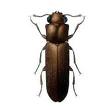
Wood Borer.

Woodworm
Anobium punctatum

Sawtooth Beetle
Oryzaephilus Surinamensis

Weevil.
Sitophilus oryzae
Booklice.
Psocids

Larder Beetle.
Dermestes lardarius
Indian Mill Moth.
Plodia interpunctella
Rice Moth.
Corcyra cephalonica

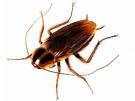

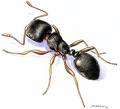
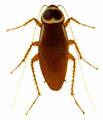
The black ant is approximantly 5mm, the Queen can be a lot bigger 15mm. Queens lay their eggs in the spring in nests that are typically in soil but can be in brickwork or under bark. Garden Ants are attracted to sweet foods and leave a pheromone trail back to their nests for other ants to follow to the food source
Pharaoh ants are small, yellow ants about 1/16-inch long. They have two nodes and the workers are all one size. the Pharaoh ant cannot survive outdoors year-round and so is found in close association with heated buildings. Colonies can grow large enough to contain as many as 300,000 workers and many queens. The queens are very mobile and so are the colonies.
Insect Pests Species
Found in the UK
Bedbugs are not very large; it is usually about 1/4 an inch long. The small body size helps this pest to hide in areas that make their elimination difficult. The bed bug nymph succumbs to pest control products easier than their adult counterparts but (just like adults) can go for long periods without food. Blood taken from humans is the preferred food of young and adult common bed bugs.
Confused flour beetles are very common pests infesting many flour mills, warehouses, and grocery stores. The adult female may live for as long as two years, depositing 300 to 400 eggs. The mature larva is brownish-white, has six legs, and is up to 13mm long. The life cycle requires one to four months when temperatures are favorable.
The adult is a small, active, brown beetle, 1/10 to 1/8 inch long, with a flattened body and six saw-toothed projections on each side of the thorax. The abdomen tapers toward the tip. Its body is well adapted for the cracks and crevices where it is often found. The larva is yellowish-white with a brown head and, when fully grown, is usually less than 1/8 inch long.
Biscuit beetles are 2-3mm long and reddish brown in colour. They have finely ridged wing cases and a three-segmented antenna. Biscuit beetles are often confused with furniture beetles/woodworm.
American Cockroach
Periplaneta americana
Austrailian Cockroach
Periplaneta australasiae
German Cockroach
Blattella germanica

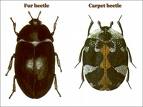
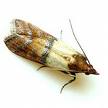



Oriental Cockroach.
Blatta orientalis

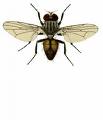

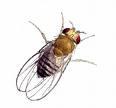


Red Ant.
Myrmica rubra



Flea
Blow Fly
Amenia
Vinegar Fly
Drosophila sp
Clustert Fly
Pollenia rudis
Lessert Fly
Fannia canicularis
Flesh Fly
Sarcophagidae
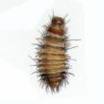
Vaired Carpet Beetle
Anthrenus verbasci
Carpet beetles can become serious pests in the home because the larvae of these insects feed only on materials such as wool, silk, hair, bristles, feathers and fur.
The adult black carpet beetle is dull black with brown legs. Adults of other species of carpet beetles (Common Carpet Beetle, Varied Carpet Beetle) are mottled with white, brown, yellow or black. Carpet beetle adults are about one eighth of an inch long. They fly readily and are attracted to light. Many of the adults feed on flower pollen. Carpet beetles breed and feed outside on dead animal material and in bird or rodent nests of dropped feathers and hairs.
The Lesser House Fly is grey black with three indistinct black stripes along the thorax. Female have grey oval abdomen; males have narrower abdomen with pale yellow patches. When at rest they hold their wings over the back forming a narrow V-shape (compared to the common house fly which forms a broader V-shape). The legs are black and the halteres yellow. It is commonly seen in the house, and has distinctive flight pattern where it darts around in square or triangular patterns in a shaft of light or under a light fitting. Size: length 5mm to 6mm
The American Cockroach is reddish brown with a yellowish margin on the body region behind the head. Immature cockroaches are similar to adults but have no wings. They are fast moving insects and scuttle for cover when disturbed.
Size length to 40mm
The German Cockroach is pale brown with two longitudinal streaks on the front part of the thorax. Adults have wings but rarely fly. They are mainly nocturnal. Young are similar to adults but wingless and dark brown (almost black), with a single lighter stripe down the middle of the back. Dense populations can leave an unpleasant small.
Size length 12mm - 16mm
The Oriental Cockroach is a fairly large species of cockroach with a dark brown to black glossy body. The female Oriental cockroach has two very short non-functional wings just below its head and a wider body than the male. The male has long brown wings covering most of the body. The male is capable short flights of 2m - 3m.
Size length to 25mm
The Australian Cockroach is a large reddish brown cockroach with yellow margin round the thorax and yellow edges to front part of fore wings. The antennae are long and the legs are spiky. They are pest in households. This is a common pest in homes and can transmit disease by contaminating food. The name is misleading as they are an introduced species from Asia.
Size 35mm
The Larder Beetle is a common insect pest of stored food products. It is a black or dark brown oval shaped beetle, with a band of pale hairs on the front half of the elytra (hardened front wings). There are patches of darker hairs within the light band forming a pattern of three spots.
Size adult beetle length 7mm to 9mm
Vinegar Flies are tiny flies that are attracted to fermenting fruit. These are the tiny flies that you see on the fruit in supermarkets and in your fruit bowl. This genus is used extensively in experiments in genetic theory as they have a very short life cycle.
Size 3mm
This Blowfly has a bright orange yellow head and brilliant metallic blue body with black cross bands on abdomen. It looks similar to the Snail Parasite Blowfly but does not have the large white spots. Not sure if it a different species of just a colour variation?
Size 12mm
The Indian Meal Moth is a small brown moth that is often a pest in stored food. Once established in can be hard to get rid of as it breeds indoors. When at rest the wings are folded together tightly by the body. The front half of the wings is a pale grey or tan. The bottom half of the wings are a rust bronze colour.
Size 10mm - 15mm
Fleas are small reddish brown wingless insects with tube-like mouthparts for feeding on the blood of their hosts. Their bodies are flattened to make it easy for them to travel through hair. The body is hard and has hairs and spines. They have long hindlegs adapted for jumping.
Size 2mm
Silverfish are small primitive insects that are found in dark, damp, warm places throughout our homes. They prefer starchy materials such as cereals, wallpaper and book bindings as food but in large populations they may do damage to cotton and linen fabrics. These wingless insects slightly resemble firebrats and are often called bristletails
Silverfish
Lepisma saccharina
Mosquito
Culicidae
Mosquitoes are well known flies with small wings. Most species are from the tropics, and anyone who has been to these parts will be familiar with the bites and the high-pitched whine of these pests. Only the females bite - they feed before breeding. The males do not feed on blood at all. Many mosquito species are disease carriers.
Size 8mm
These are small yellowish or brownish moths. Larvae spin a silken tube or case which they drag with them to protect them from the environment and their natural enemies. Eggs are laid on products the larva will consume such as: wool, feathers, fur, hair, animal and fish meals and milk powders. Adults do not feed on fabrics, only the larva damage household goods. They are not attracted to light, preferring dark, protected areas.
booklice are common but harmless insects between 1 and 2 mm long, which survive in dry powdery foods. They prefer to live in dark, warm, humid places such as the folds in packaging in food cupboards, and dislike light or disturbance. They feed on a wide variety of dry food products such as flour and also the microscopic moulds that develop in humid conditions. They may live for over six months during which time the female may lay up to 100 eggs.
Wasps bodies bear the characteristic black and yellow bands and they have a narrow waist in the middle of the body. The worker is 10-15mm in length and the queen is usually 20mm in length, both have two pairs of wings which lock together. Only females have the ability to sting, which is near the tip of the abdomen.
Several species of wasp exist in the UK but most abundant are the Common and German wasps. Both these species nest underground or in the cavities of trees, walls and other parts of buildings
Wasp
Vespula Vulgaris
Flesh flies are common, conspicuous flies. This specimen measures about 12mm from head to tail. Flesh flies differ from the tachinid flies in that they lack the postscutellum, the large swelling underneath the scutellum on the thorax. Flesh flies have a prominent row of bristles (setae) on each side of the thorax just above the base of the hind leg in addition to another row of bristles just under the base of the wing. These two sets of bristles differentiate the flesh flies from the Muscid flies: they rarely have both sets. They most resemble blow flies, but are never metallic colored. They generally have highly contrasting black and grey stripes on the thorax, as well as a checkerboard-like pattern on the abdomen.
Weevils have chewing mouthparts at the end of their snouts or prolonged heads, and are about 1/8- to 3/16-inch long, depending on the size of the grain kernel. In small grains, such as millet or milo maize, weevils are small in size; they are larger in corn. the adult rice weevil is a dull reddish-brown with round or irregularly shaped pits on the thorax and four light spots on the wing covers. Weevils in the larval stage are legless, humpbacked, white to creamy white, with a small, tan head. Weevils in the pupa stage have snouts like the adults. The maize weevil is similar to the rice weevil, but larger.
Adults are 6 to 12mm long and their wings are pale buff-brown. Females lay 100 to 400 eggs in or near the foods. The larvae infest many dried foods such as grains, oil seeds, beans, dried fruits, spices, and beverages. They produce a large amount of webbing and frass before spinning a dense white cocoon. The larvae develop into adults in about two months.
The sizes of workers, ranging from 1/8-inch to almost 3/8-inch in length
The red imported fire ant was brought into this country during the 1920s and has spread to cover most of the states. These ants nest in the soil and construct large mounds that are easily seen in lawns and farms. A single lawn may contain a dozen or more mounds. This ant will also locate nests within landscape mulch and beneath items on the ground. Fire ants may construct mounds next to the foundation and enter homes through holes or other exterior cracks.
The female lays her eggs into cracks in wood or inside old exit holes, if available. The eggs hatch after some three weeks, each producing a 1 mm long, creamy white, C-shaped larva. For three to four years the larvae bore semi-randomly through timber, following and eating the starchy part of the wood grain, and grow up to 7 mm. They come nearer to the wood surface when ready to pupate. They excavate small spaces just under the wood surface and take up to eight weeks to pupate. The adults then break through to the surface as adults, making a 1mm to 1.5 mm exit hole and spilling dust, the first visible signs of an infestation.
The larvae of the old house borer sometimes infest softwoods. The adult beetle is grayish-black, 1/2 to 3/4 inch in length with several white markings on the wing covers and long antennae. The female lays eggs in crevices of logs or timbers. The larvae hatch and require 3 to 5 years or more to mature. The larvae are 1/2 to 1 1/2 inches long and are white, segmented and have an enlarged, brownish head. They bore through the wood making irregular galleries. During quiet times, their feeding may be heard as a clicking or rasping sound. The beetles emerge through an oval hole about 1/4 to 3/8 inch in diameter
Crawling & Flying Insect Control


Telephone: 020 8616 6782 Mobile: 07432 022 541

©2016 All Rights Reserved Web by RAPC
Company Registration Number: 06610444 Infest-a-Cure Ltd / TA Rest Assured Pest Control Address: 253b Chingford Mount Road, Chingford, London E4 8LP